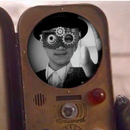Introduction: Rechargeable Handheld Capacitor Flashlight
Most flashlights nowadays use store bought alkaline batteries to power them. Battery companies are making their batteries last longer and longer. After a good camping trip, most batteries will run out after the constant use. There are rechargeable batteries such as Ni-Mh and Ni-Cd rechargeable batteries. The problem with these batteries is their toxicity. Instead of using batteries, how about we take a different path. This flashlight is completely powered on energy stored in electrolyte capacitors. They last for a long period of time and can be recharged hundreds of times.
Step 1: Tools and Materials
I got most of these parts from RadioShack. You can probably find all of these materials at a local electronics store or hobby shop.
Materials:
- 4700µf 35v electrolytic capacitor x2
- 470Ω resistor
- 3.5v high brightness 10mm white LED
- large push button switch
- general purpose perf board
- red 20 gauge wire
- black 20 gauge wire
- female and male banana plugs
- hard thick plastic
- 12v DC power source
I got the thick plastic material from a lighter handle. The 12v power source is supposed to be something that you can charge your flashlight from. This can be done from an outlet transformer, a car port, or even a 12v solar cell.
Tools:
- screw gun and drill bits
- soldering iron
- solder
- wire cutters
- super glue
- electrical tape
Step 2: Connect the Capacitors
First bend the leads downwards so they look like the picture above. Place the capacitors side by side on the perf board. You should have some room on the perf board to solder the LED and the other components there. Bend one capacitors leads to the other capacitors leads and solder them together. It should look like the image above. The capacitors should be connected in a row and not in series. They now have 9400µf to store energy for your flashlight.
Step 3: Add the LED
Place the LED, the switch, and the resistor onto the perf board. Use the leads to connect the parts together. Make sure that all of the components have the right leads going to the right parts and pieces. One lead of the switch will go to the positive lead of the capacitors. This is the side that you will add a positive charge to. The other end of the switch will be connected to the positive lead on the LED. The negative lead on the LED should be connected to one of the resistors leads. The other end of the resistor is then connected to the negative lead of the capacitors. If you have one, I suggest you first test this circuit on a breadboard.
Step 4: Prepare the Charging Section
Cut a piece of the thick plastic about the width of the perf board. Bend the plastic 90% so that it can be glued onto the rim of the perf board. Hold the piece onto the perf board like shown above and mark two points on the plastic piece the lines up with the leads on the capacitors. Then use a screw gun to drill two holes on the points you made. The female banana plugs should be able to fit in the holes.
Step 5: Attach the Charging Ports
Solder wire leads to the female banana plugs. Red is positive and black is negative. Strip the other ends of the wires so they can be soldered to the perf board. Get the wires in place on the perf board. Then super glue the Plastic piece to the perf board like shown above. Solder the wires to the perf board so that the positiven wire goes to the positive end of the capacitors and the negative wire goes to the negative end of the capacitors. You have finished the flashlight.
Step 6: Prepare the Charging Power
To recharge the flashlight you need to get a 12v power source. It should be in DC current. I had a 12v computer charger that plugs into the wall. You can also use batteries, a car port, a 12v solar module, or other alternative 12v power sources. First you strip the wires that come from your power source. Connect the positive wire to the positive male banana plug and the negative wire to the negative male banana plug. If you have some exposed wire you should wrap electrical tape around it.
Step 7: Charge and Run
To charge your flashlight turn on or plug in your 12v power source. Then plug the banana plugs into the flash light. It only takes around one second to charge. Unplug your flash light and push the button. The LED should light up but not burn out. Take your flashlight camping and use it to light up the night. With my power source the LED stayed lit for around 45 minutes before it dimmed and then went out. You can also make this flashlight better by using a voltage regulator instead of a resistor. you can also put the flashlight inside a project box to protect it. I decided to leave mine open.
Attachments

Participated in the
MAKE ENERGY: A US-Mexico Innovation Challenge

Participated in the
On a Budget Contest

Participated in the
Apocalypse Preparedness Contest












